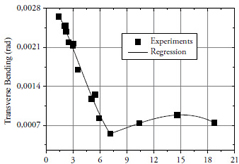Development of a neural network model to predict distortion during the metal forming process by line heating
DOI:
https://doi.org/10.25043/19098642.77Keywords:
network model, plate forming, distortion prediction, line heating, back propagationAbstract
In order to achieve automation of the plate forming process by line heating, it is necessary to know in advance the deformation to be obtained under specific heating conditions. Currently, different methods exist to predict deformation, but these are limited to specific applications and most of them depend on the computational capacity so that only simple structures can be analyzed. In this paper, a neural network model that can accurately predict distortions produced during the plate forming process by line heating, for a wide range of initial conditions including large structures, is presented. Results were compared with data existing in the literature showing excellent performance. Excellent results were obtained for those cases out of the range of the training data.
Downloads
References
CHANG, C.W.; LIU, C.S. AND CHANG, J.R. (2005): A Group Preserving Scheme for Inverse Heat Conduction Problems. CMES: Computer Modeling in Engineering & Sciences, 10, 1, pp.13-38.
CHENG, P.; YAO, Y. L.; LIU, C.; PRATT, D.; FAN, Y. (2005): Analysis and Prediction of Size Effect on Laser Forming of Sheet Metal. Journal of Manufacturing Process, SME Vol. 7/No.1; 28-40.
VEGA, A. (2009): Development of Inherent Deformation Database for Automatic Forming of Thick Steel Plates by Line Heating Considering Complex Heating Patterns. Doctoral Thesis. Osaka University, Japan, 2009.
LIU, C.S. (2006): An Efficient Simultaneous Estimation of Temperature-Dependent Thermophysical Properties. CMES: Computer Modeling in Engineering & Sciences, 14, 2, pp.77-90.
MOSHAIOV, A. AND LATORRE, R. (1985): Temperature Distribution during Plate Bending by Torch Flame Heating. Journal of Ship Research, 29, 1, pp.1-11.
LIU, C.S. (2006): An Efficient Simultaneous Estimation of Temperature-Dependent Thermophysical Properties. CMES: Computer Modeling in Engineering & Sciences, 14, 2, pp.77-90.
C. D. JANG, J. S. KIM AND Y. S. HA AND Y. H LEE (2005). Prediction of Plate Deformation Considering Film Boiling in Water Cooling Process after Line Heating. ISOPE’2005, pages 191-197.
OSAWA, N.; HASHIMOTO, K.; SAWAMURA, J.; KIKUCHI, J.; DEGUCHI, Y. AND YAMAURA, T. (2007): Development of Heat Input Estimation Technique for Simulation of Shell Forming by Line-Heating. CMES: Computer Modeling in Engineering & Sciences, 20, 1, pp.45-53.
TANGO, Y, ISHIYAMA, M, NAGAHARA, S, NAGASHIMA, T, AND KOBAYASHI, J, (2003). "Automated Line Heating for Plate Forming by IHI-ALPHA System and its Application to Construction of Actual Vessels-System Outline and Application Record to date," Journal of the Society of Naval Architects of Japan. Vol. 193. pp. 85-95.
TERASAKI, T.; KITAMURA, N. AND NAKAI, M. (1999): Predictive Equation for Thermal Cycle Generated by Line Heating Method. Trans. The West-Japan Soc. Naval Architects, 99, pp.321-329 (in Japanese).
VEGA, A., RASHED, S., TANGO, Y., ISHIYAMA, M., MURAKAWA, H. (2008): Analysis and prediction of multi-heating lines effect on plate forming by line heating. CMES Journal: Computer Modeling in Engineering & Sciences, CMES, Vol. 28, No. 1, pp. 1-14, 2008.
JAIN A., MAO J., MOHIUDDIN A. (1996), “Artificial Neural Networks: A tutorial”, IEEE Computer Society. 1996.
GURVEY K. (1997), “An introduction to Neural Networks”. UCI Press Limited, 1997.
HAGAN M., BEALE M., DEMUTH H. (1996), “Neural Network Design”. PWS Publishing Company, Boston, MA, 1996.
FAUSETT L. (1994), “Fundamentals of neural networks, architectures, algorithms and applications”. Englegood Cliff. NJ; Prentice – Hall. 1994.

Published
How to Cite
Issue
Section
License
The authors who publish in this Journal certify that:
- The work submitted for publication in The Ship Science and Technology journal, was written by the author, given that its content is the product of his/her direct intellectual contribution.
- All data and references to material already published are duly identified with their respective credits and are included in the bibliographic notes and quotations highlighted as such.
- All materials submitted for publication are completely free of copyrights; consequently, the author accepts responsibility for any lawsuit or claim related with Intellectual Property Rights thereof, Exonerating of responsibility to The Science and Technology for the Development of Naval, Maritime, and Riverine Industry Corporation, COTECMAR.
- In the event that the article is chosen for publication by The Ship Science and Technology journal, the author state that he/she totally transfers reproduction rights of such to The Science and Technology for the Development of Naval, Maritime, and Riverine Industry Corporation, COTECMAR.
- The authors retain the copyright and transfer to COTECMAR the right of publication and reproduction of the work which will be simultaneously subject to the Creative Commons Attribution License (CC -BY) , which allows the license to copy, distribute, display and represent the work and to make derivative works as long as it recognizes and cites the work in the manner specified by the author or licensor.
- For more information about the Creative Commons Attribution License (CC -BY) and his use and scope, please visit the following web page https://creativecommons.org/licenses/by-sa/4.0/legalcode








